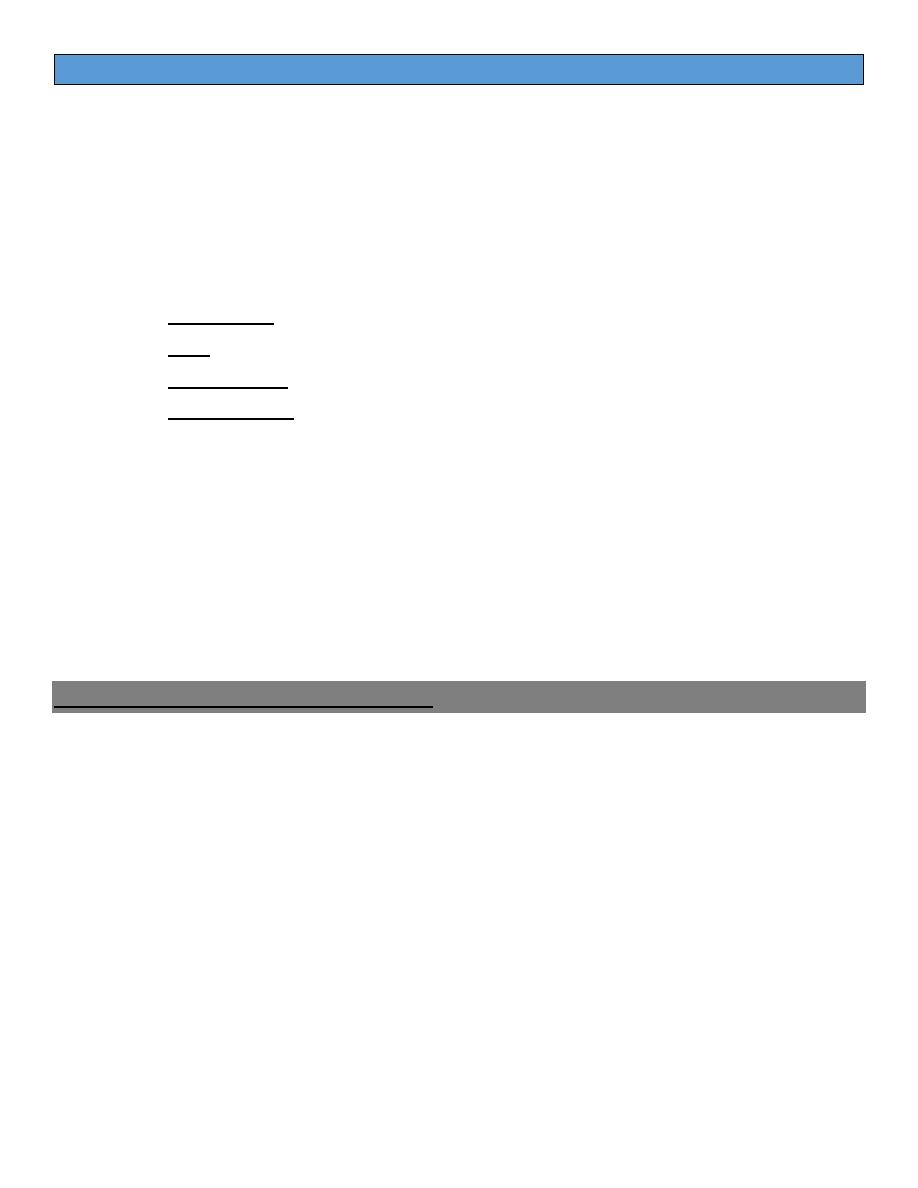
P a g e | 1 URO-SYMPTOMATOLOGY G:E
Uro-Symptomatology
1. Pain
Analysis of pain includes:
Site, Character, Reference (Radiation)
Severity, What ↑&↓, Associated symptoms
Q: What is the difference between Referred pain & Radiated pain?
Referred pain: Pain felt in certain area as well as felt in another part
supplied by the same dermatomal nerve supply with area of freedom in
between e.g. renal pain →testis
Radiated pain: Pain felt in certain area as well as felt in another area
supplied by the same dermatomal nerve supply without area of freedom
in between e.g. renal pain → epigastrium, Appendicitis → around
umbilicus
Site of pain:
A. Renal pain.
B. Ureteric pain.
C. Bladder pain.
D. Prostatic pain.
E. Testicular pain.
F. Epididymal pain.
a. Renal pain: All types of pain can occur in kidney but the commonest are:
Colicky pain (most common)
Dull aching pain.
1- Dull aching pain: due to distension of renal capsule. e.g.
- Acute inflammation of the kidney.
- Bleeding in a cyst.
- Peripheral renal tumour.
- Renal abscess.

P a g e | 2 URO-SYMPTOMATOLOGY G:E
- Acute hydronephrosis.
- Character:
Site: renal angle.
Refers to: hypochondrium.
↑ with: exercise.
↓with: analgesics (NSAID).
2- Renal colic: Most common cause is stone.
- Definition of colic: spasmodic pain which occur in hollow viscous
or tubular structure lined by smooth muscle due to contraction of
these muscles in an attempt to get rid of an obstructing agent.
- Character:
colicky pain in renal angle.
may radiate to epigastrium.
not related to posture
may be relieved by NSAlDs.
may be associated with nausea, vomiting & diaphoresis.
DD from pain in loin which is mostly due to radiculitis (post. nerve
root) → in female (short & obese), related to posture.
b. Ureteric pain:
1- Upper third: (T11 - Ll symp.) colicky pain similar to that of renal
colic.
2- Middle third: should be differentiated from appendicitis on Rt side
& diverticulitis on Lt side.
3- Lower third: (T12 - L2 symp.) (S2,3,4 parasymp.) most common
causes are stones & stricture.
- Criteria: As renal colic +
Referred to scrotal skin in male & labia major in female.
may be referred to tip of penis.
pain usually associated with Irritative voiding symptoms
(frequency, urgency)

P a g e | 3 URO-SYMPTOMATOLOGY G:E
c. Urinary bladder Pain: Common causes
- full bladder (most important)
- cystitis.
- stones
- Malignancy
- Criteria:
- Character: dull aching or discomfort.
- Site: supra-pubic region.
- Referred to: tip of penis.
- Relieved by: evacuation of bladder in full bladder.
d. Prostatic Pain: may be acute or chronic.
- Acute pain:
severe pain in the perineum.
associated with:
- dyschasia (rectal dysentery)
- high grade fever.
- urine retention.
MCQ: Triad of acute prostatic pain?
e.g. acute prostatitis, prostatic abscess.
- Chronic pain:
pain in perineum, lower abdomen, around anus, tip of penis.
age around 20-40 y.
due to chronic prostatitis. (only complication is repeated UTI
& is not perfectly treated medically)
e. Urethral Pain:
- Causes: stone or inflammation.
- Character: burning pain in urethra.
f. Testicular Pain: Cause testicular sensation in syphilis; malignancy.
g. Epididymal Pain: most common cause is epididymo-orchitis.

P a g e | 4 URO-SYMPTOMATOLOGY G:E
2. Symptoms related to act of micturition: Include
a. Obstructive voiding symptoms:
Causes:
infra-vesical obstruction.
the commonest → elderly ♂ with BPH.
- Criteria:
weak & narrow urinary stream.
difficulty → to initiate (Hesitancy), to maintain (Intermittency), to
terminate (Post-micturition dribbling)
sense of incomplete voiding.
retention of urine (acute or chronic)
b. Irritative voiding symptoms: due to bladder & urethral irritation
(Malignancy, cystitis, stone)
- Criteria:
- Frequency: by day (Diurnal) "N. 3-5 times
”, by night (Nocturia) "N. 0
- 1 times"
- burning micturition. (Scolding)
- urgency: strong desire to micturate which can't be postponed, can't
hold urine whenever desire develops.
- urge incontinence: strong desire to micturate which can't be
postponed and if postponed
→ involuntary escape of urine drops.
c. Day & Night Incontinence:
- stress incontinence.
- urge incontinence (neurogenic, stone, cystitis, malignancy)
- Total incontinence as in
→ VVF (vesico-vaginal fistula), → congenital
(ectopia vesica)
- Paradoxical incontinence (false): retention with overflow as in BPH &
urethral stricture.
1- Volume:

P a g e | 5 URO-SYMPTOMATOLOGY G:E
- Normally
— 0.5 - 1 ml / kg / h (800 - 1600 ml / day) ↓↓ volume
-
< 400 cc / 24 h → oliguria (least volume to excrete toxic metabolite
from the body)
-
No urine / 12 h (with empty bladder) → anuria
2- Colour:
-
Normally → golden or amber yellow.
- Red
urine → blood → haemoglobinuria, myoglobinuria, drugs
(Rifampicin)
3- Aspect:
-
Normally → clear.
-
Turbid urine → pyuria, proteinuria, chyluria, crystalluria
-
Pneumaturia (air in urine) → UT1 by gas forming organism, vesico
colonic or iliac fistula?
3. GIT symptoms;
(3A) - Anemia (pallor) - Asthenia (weakness). - Anorexia. - Headache.
e.g. renal colic with nausea & vomiting, pyelitis in newborn with
gastroenteritis.
4. Change in physical character of urine: due to:
Reno-intestinal reflex.
peritoneal irritation.
organ relationship.
5. Metastasis symptoms: Brain, Bone, liver, lung, other kidney and others.
6. Masses:
a. renal mass.
b. bladder mass
- full bladder is a cystic pelvi-abdominal swelling which you can't get
below.
- palpation & percussion of the mass lead to desire for micturition.
- mass disappear after voiding.

P a g e | 6 URO-SYMPTOMATOLOGY G:E
7. Sexual dysfunction: -
♂&♀: libido, erection, ejaculation, orgasm,
infertility.
Anuria
Def: No urine excretion for 12 h. OR excretion of < 400 cc / 24 h (with
empty bladder) = oliguria.
Types: (Aetiology)
1- Pre-renal causes:
- shock (hypovolemic, septicemic, cardiogenic, neurogenic)
- heart failure.
- hemorrhage (hge).
- N.B: MAP = DB
P + ⅓ pulse pressure = 95 mmHg.
2- Renal causes:
- due to bilateral renal disease (dse).
1- Diseases:
acute glomerulonephritis (AGN)
SLE.
PCK (polycystic kidney)
2-Toxic: - endogenous, (bile)
exogenous: NSAIDs, aminoglycosides (streptomycin), anti. TB (INH)
3- Post-renal causes:
obstruction → bilateral, → unilateral with solitary kidney.
infiltration of both ureters by Mg. e.g cancer Cx.
accidental ligation of both ureter e.g. during hysterectomy.
stricture.
-Diagnosis:
History: of urinary stone. SLE, drugs.
Symptoms:
- renal colic.
- anuria.
- uremic symptoms: headache, drowsiness, lassitude, nausea,
hiccough, constipation.

P a g e | 7 URO-SYMPTOMATOLOGY G:E
- lastly, subnormal temperature, irregular breathing, muscle
twitches → coma & death.
- Examination;
1st exclude retention by percussion of bladder & catheter.
uremia (earthy look with acidotic breathing)
palpation of kidney → ↑size of kidney. → tender → obstruction.
P.V or PR to find Mg. Which is common cause of post-renal anuria.
DD: from urine retention.
- Investigations:
a. Laboratory:
- ↑
S. urea & ↑ creatinine (1st)
- K & Na.
-
ABG → PH, O2 saturation & HCO3
b. Radiology:
-
U/S → most important. 50 % of Diagnosis
- Plain X-
ray → stones.
- C.T (±)
- Treatment:
1- Pre-renal:
- ttt of the cause.
- replacement therapy.
2- Renal: ttt of the cause.
3- Post-renal:
Cystoscopic catheterization of both ureters.
PCN (Percutaneous Nephrostomy) if obstruction.
Treatment of the cause.
4- Indications of hemodialysis:
- HCO3 < 12mEq/L.
- Pulmonary Oedema.
- K > 7 mEq / L.

P a g e | 8 URO-SYMPTOMATOLOGY G:E
- ECG changes.
Retention of Urine
Def: inability to evacuate full bladder.
Types:
1- Acute retention: acute onset, complete retention & painful.
2- Chronic retention: gradual onset, may be with overflow & painless.
3- Acute on top of chronic
A- Acute retention
Def.: sudden failure to pass urine although the bladder is full.
1. Obstructive (mechanical):
bladder: BNO, stone & Tumors.
prostate: BPH (old age), abscess & carcinoma.
urethra: stone (adolescence), stricture, PUV (child)
pelvis: Tumors.
2. Functional (Neurogenic)
a. spastic (sphincter) as in spinal anesthesia.
b. atonic (bladder) as in senility, spinal cord lesion, atropine.
3. Hysterical: common in females.
C/P:
sever desire to micturate but he can't do.
severe suprapubic bursting pain which may be periodic.
full bladder on percussion.
B- Chronic retention
Def: it's gradual distention of bladder with increasing the residual urine.
1. Obstructive:
- BPH
- BNO
- Cancer prostate.
- stricture urethra
- ureterocele (common cause of urine retention in girls)

P a g e | 9 URO-SYMPTOMATOLOGY G:E
2. Neurogenic: spinal cord lesion.
C/P:
- history of the cause.
- painless.
- huge UB
- no tenderness.
- dribbling of urine (retention with overflow) 9
Investigations:
- Acute retention: endoscopy.
- Chronic retention: urodynamic study.
Treatment:
1- Hospitalization.
2- Conservative:
- sedation with morphine.
- hot fermentation on suprapubic region.
- psychological help.
3- Catheterization:
-
Foley's catheter → If failed → Nelaton's cather → If failed →
Percutaneous suprapubic puncture.
-
Catheter size → child (6 - 12 french) → adult ( 16-20 french)
N.B: Cancer Cx in female usually associated with retention of urine and not
anuria.
Hematuria
Def: presence of > 3-5 RBCs / H.P.F in concentrated urine.
Types:
1- According to the severity:
a) gross haematuria.
b) microscopic haematuria (< 5 / H.P.F)
2- According to the relation to the urinary system:

P a g e | 10 URO-SYMPTOMATOLOGY G:E
-
initial → urethra.
-
terminal → bladder & post. urethra (Bilharz.)
-
total → kidney, ureter or bladder.
3- According to the associated pain:
10
- painful (e.g. stones)
- painless (e.g. renal & UB tumours)
4- True or false.
5- Factitious haematuria.
6- According to the origin.
- urologic: from peripheral calyces to external meatus.
- Nephrologic: glomerular in origin.
Aetiology:
I- Urologic:
- trauma.
- stones.
- infection.
- neoplasm.
- BPH
- iatrogenic.
II- Nephrologic:
- PSGN.
- SLE.
- Exercise haematuria.
III- Haematologic:
- hemophilia.
- ITP
- DIC
- sickle cell anemia.
- V.W dse.
IV- Exercise haematuria:
e.g. long distance runner.

P a g e | 11 URO-SYMPTOMATOLOGY G:E
V- Factitious: vaginal bleeding.
VI- Idiopathic: 20%
Diagnosis:
A) History:
1- Age:
a-
child → most common nephrologic cause → PSGN → most common
urologic cause
—> UTI
b-
adult → most common causes → stones & tumours.
c-
old age male → B.P.H. & cancer bladder
2- Sex: f
emale → ask about menstruation. most common in female → cystitis.
3- Analysis of haematuria:
a-
Colour of haematuria: smoky urine (coca cola colour) → PSGN
b- Time of haematuria:
1.
initial → urethral causes.
2.
terminal → bladder causes.
3.
total → kidney, ureter or bladder causes,
c- Shape of blood clots:
1.
discoid → vesical causes.
2.
worm like → supra-vesical cause,
d- Other symptoms:
1.
frequency → diurnal → stone bladder. → nocturnal → BPH. →
diurnal & nocturnal → cystitis.
2.
pain → colicky → stone. → dull aching → inflammation.
e- Past history of: - trauma. - drugs e.g. rifampicin - passage of stone
B) Examination:
1- General:
- vital parameters:
Temp → infection.
Hypertension → Oedema LL.

P a g e | 12 URO-SYMPTOMATOLOGY G:E
Oedema LL: nephrotic syndrome.
purpuric rash: ITP.
2- Abdominal:
- renal masses: renal causes or hydronephrosis due to lower causes
- full bladder: BPH.
- cirrhotic liver: bleeding tendency.
12
3- PR or PV: - bladder mass. - BPH. - cancer prostate.
C) Investigations:
a- Laboratory:
1- urine: - urine analysis. - urine culture. - urine cytology. - Zeihl Neelsen.
2- Blood: - CBC. - ASO titre. - haematologic tests (Bleeding & clotting
times)
b- Imaging: - KUB X-ray. - IVU - Ascending cystography. - Angiography. -
Abdominal U/S. - CT
c- Endoscopy: cysto-urethroscope.
d- Renal biopsy.
D) DD:
a- Causes of red urine:
haemoglobinuria. - myoglobinuria. - food e.g. beet root
Drugs e.g. rifampiein, adriamycin, metronidazole.
N.B: Cyclophosphamide → haemorrhgic cystitis → haematuria.
b- Causes of urethral bleeding.
Treatment
1.
General measures: for shocked patient → IV fluids, blood transfusion,
continues blood irrigation.
2. Definitive treatment of the cause.
12
